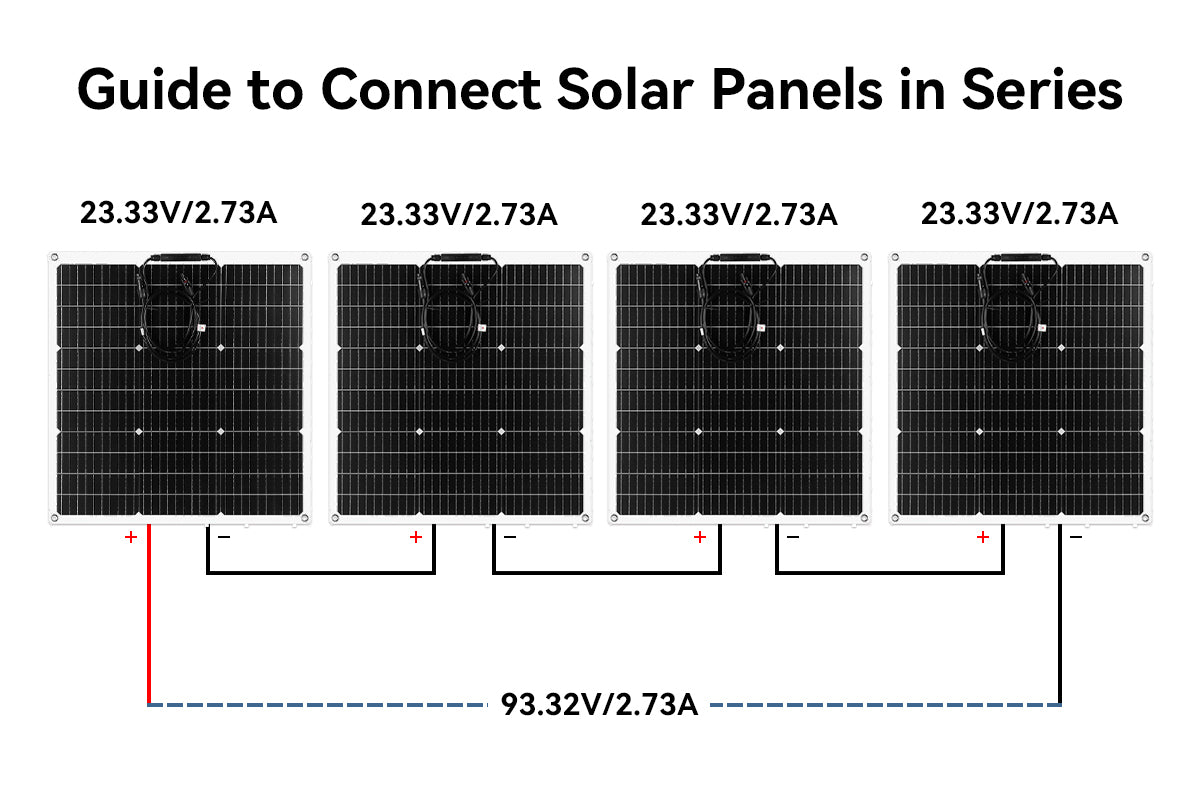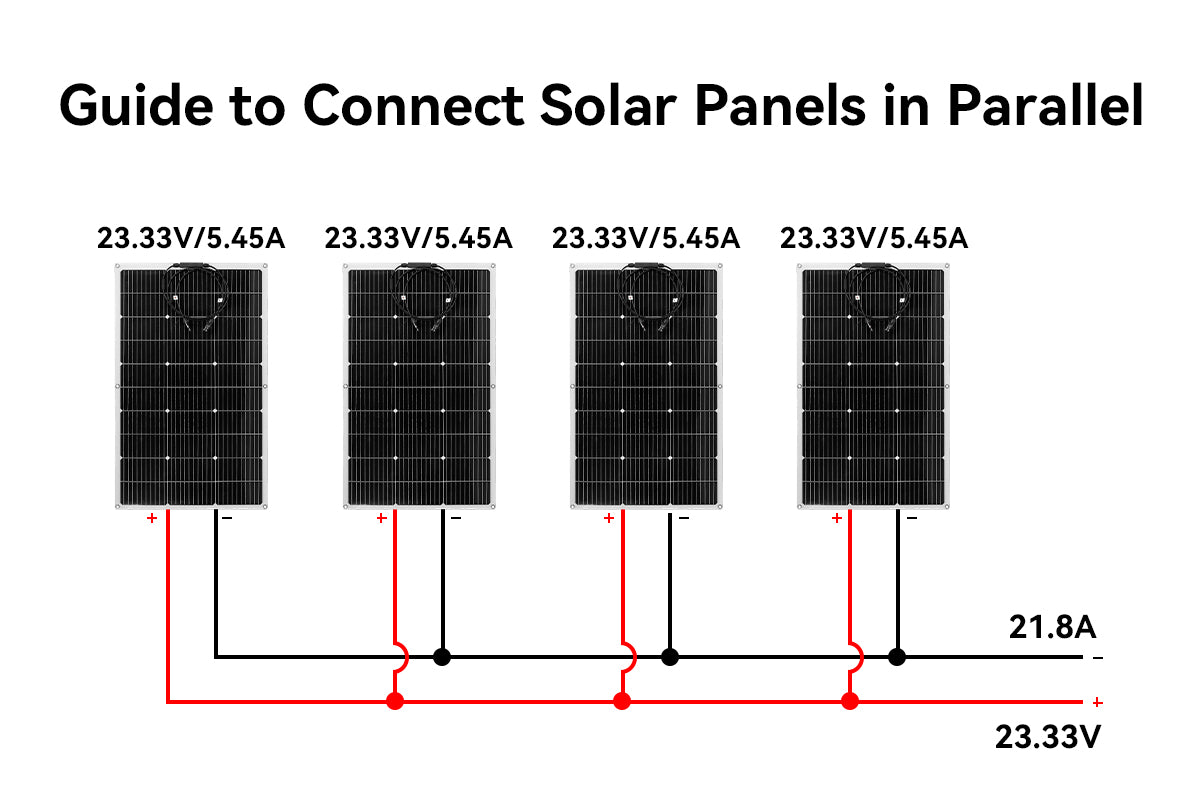Once you’ve determined how many solar panels you need, the next step is designing the solar array. Connecting solar panels in series is a common approach. At this stage, it’s crucial to align the series configuration with the specifications of your solar charge controller or hybrid inverter. This ensures safety, efficiency, and maximum energy output from your system.
In this guide, we focus on the series connection of solar panels, including its advantages, potential risks, and how to calculate the maximum number of solar panels can be connectedion series.
What does it mean connecting solar panels in series
Wiring solar panels in series means connecting the positive terminal of one panel to the negative terminal of the next, which increases the system's voltage while maintaining the same current. This configuration is particularly suitable for high-voltage applications and works optimally with MPPT charge controllers.
For example, if you connect three 12V solar panels rated at 5A in series, the total voltage becomes 36V, while the current remains 5A.
Advantages of connecting solar panels in series
1. The increased voltage in a series connection reduces power loss (P = I²R) and minimizes voltage drop, improving efficiency over long wire runs.
2. Since series wiring maintains power with lower current, thinner and cheaper cables can be used, cutting installation expenses.
3. Compared with wiring solar panels in parallel, series connections eliminate the need for multiple combiner boxes and extra fusing, simplifyning system design.
Risks of connecting solar panels in series
1. The shade affect the the production of solar array, especiall in series connection, if one panel is shaded, dirty, or underperforming, the entire string’s output drops significantly.
2. Connecting solar panels in series not only increase the voltage but also the risk of overvoltage, if no propoer design potencially damage equiment and electric shock.
Next, we will explain how to calculate the maximum number of solar panels you can safely wire in series.
Calculation of the number of solar panels in a series string
After determining how many solar panels your system needs, the next important step is to ensure your solar array’s total power and voltage stay within the limits of your hybrid inverter or charge controller.
Step 1. Check the maximum PV input power
Make sure the total wattage of all your solar panels does not exceed the maximum PV input power rating of your inverter or charge controller. This protects your equipment from overload and potential damage.
Step2. Calculate how many solar panels can be wired in series
The number of solar panels you can safely connect in series depends on the voltage limits of your MPPT charge controller or hybrid inverter. There are 2 key boundaries to consider:
- To ensure your system starts charging efficiently, the series voltage must reach at least the MPPT’s start voltage. This allows the controller to activate and begin tracking power, even under low-light conditions.
Min solar panels in series =MPPT Start Voltage/Individual Solar Panel's Open Circuit Voltage (Voc)
- At the same time, the total voltage of your series string must stay below the maximum PV voltage input of the inverter or controller to prevent overvoltage, especially in cold weather when Voc increases. Exceeding this limit can damage your equipment.
Max solar panels in series =Inverter/Charge Controller's Maximum PV Voltage Input / Individual Solar Panel's Open Circuit Voltage (Voc)
Generally, for RV solar setups, solar panels usually have an open-circuit voltage (Voc) between 18V and 24V. MPPT charge controllers commonly used in RVs support a maximum input voltage of 100V to 150V. Based on this, you can typically connect 3 to 6 panels in series.
In residential solar systems, panels often have a higher Voc, ranging from 38V to 48V. Residential inverters usually allow input voltages from 450V to 600V, sometimes even up to 1000V in large installations. This means you can usually connect between 8 to 14 panels in series.
Note:
⚠️ Always use the open-circuit voltage (Voc) rating of your solar panels, and apply a temperature correction factor if your area experiences low temperatures (cold weather increases Voc).
How to connect solars panel in series
Let’s go through a practical example to see how to design solar array and connect solar panels in series and save safe in a real-world scenario.
Assuming a 400W solar system made of eight 50W panels, each with an open-circuit voltage (Voc) of 23.33V and short-circuit current (Isc) of 2.73A, you need to design the wiring to match the specifications of a 45a charge controller, which has a maximum PV input voltage of 100V.
Connecting all eight panels in series results in 186.64V, exceeding the controller’s limit and risking equipment damage.
To stay within safe limits, divide the controller’s voltage limit (100V) by the panel’s Voc (23.33V), which equals about 4.28. Since you can't exceed the limit, round down to four panels per string. That means the 8 solar panels should be connected using a series-parallel configuration, with two strings of 4 panels each connected in parallel.

Here’s how to wire the panels in a safe and effective series-parallel configuration:
1. Group the panels
Divide the 8 panels into two groups of 4.
2. Connect each group of 4 panels in series
For each group, connect the positive (+) terminal of the first panel to the negative (–) terminal of the second panel. Continue this pattern until all 4 panels are linked in a chain. At the end of each string, you’ll have one free positive wire and one free negative wire.

3. Repeat for the second group
Do the same for the second set of 4 panels to create a second identical series string.
4. Connect the two series strings in parallel
Take the positive wires from both strings and connect them together. Do the same with the negative wires. Use a PV combiner box or a suitable parallel connector for a safe and reliable connection.
This setup keeps the total voltage at 93.32V (4 × 23.33V) and increases the current to 5.46A (2.73A × 2), which is safely within the 45A input limit of the charge controller.
FAQs on solar panel series connection
Can i string together different wattage solar panels together
Not recommended. In series wiring, all panels must carry the same current. If you connect a 100W (5.56A) panel with a 150W (8.3A) panel, the entire string will be limited to the lowest current, which results in wasted power potential.
Mixing panels with different voltages can also cause imbalance and reduce overall efficiency. To ensure a stable and efficient system, always use identical solar panels in series connections.
What happens if one panel is shaded in a series string?
The current drops to the lowest-performing panel’s level, reducing the output of the whole string. Use bypass diodes or avoid shade. Even partial shading can significantly impact energy production in series connections, so proper panel placement and design are critical.
What type of charge controller is better for serial solar panel connection?
An MPPT charge controller is better for series-connected solar panels. It efficiently converts excess voltage into additional current, especially when input voltage is higher than battery voltage, maximizing energy harvest and performance across varying sunlight conditions.


